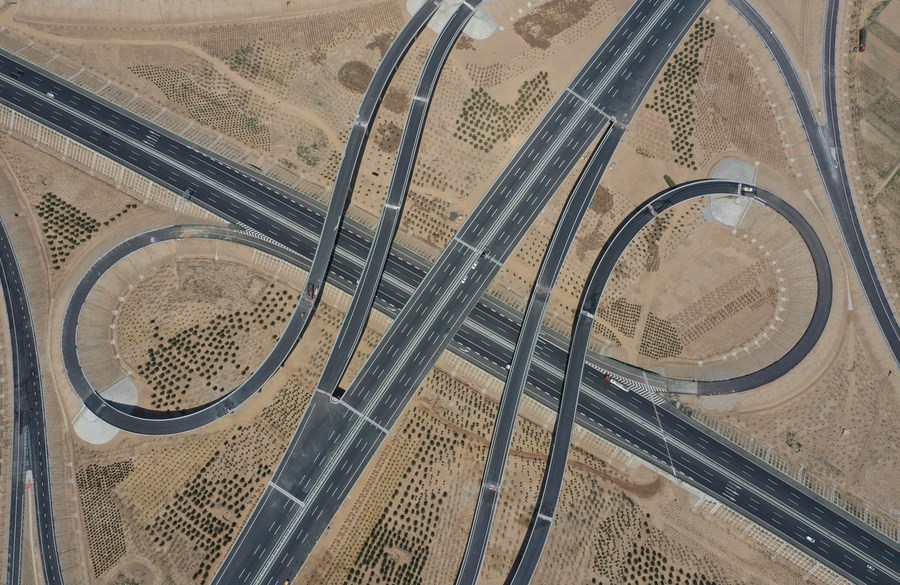Beijing, neighboring regions further integrated for high-quality development
* The transportation development has been a basis for the coordinated development of the Beijing-Tianjin-Hebei region. A "one-hour traffic circle" now exists between Beijing, Tianjin, and cities in Hebei.
* The connectivity has significantly alleviated urban congestion in Beijing, stabilized housing prices, and driven up public services development in Beijing's neighboring areas.
* Beijing's two "wings" -- the municipal administrative center in Tongzhou District and Xiong'an New Area -- both aimed at relieving Beijing functions non-essential to its role as China's capital are taking shape.
BEIJING, Feb. 24 (Xinhua) -- Coordinated development in Beijing and neighboring regions now exerts vigor, eight years after China initiated a vital strategy to nurture a Beijing-Tianjin-Hebei regional city cluster.
The just-closed Beijing 2022 Olympic Winter Games with competition zones in Beijing and neighboring areas further tapped the potential of the concerted regional city cluster development.
In the meantime, Beijing's two "wings" -- the municipal administrative center in Tongzhou District and Xiong'an New Area -- both aimed at relieving Beijing functions non-essential to its role as China's capital are taking shape.

Photo taken on Jan. 21, 2022 shows a train running on the Beijing-Zhangjiakou high-speed rail line in Beijing, capital of China. (Xinhua/Liu Xu)
BALANCED DEVELOPMENT APPROACHES
China initiated the strategy of coordinating the development of the national capital of Beijing and neighboring Tianjin Municipality and Hebei Province in early 2014 to create a model with a better economic structure, cleaner environment, and improved public services.
Although the three places are geographically adjacent, their development levels are not in sync with resources highly concentrated in Beijing.
Eight years on, a national-level fintech demonstration zone has replaced the former largest wholesale clothing market in Beijing.
The market, near the Beijing Zoo, used to see more than 30,000 sellers and an average daily visitor flow of 100,000. Resident Shen Jie recalled the roadside space packed with minivans and vendors in the market's heyday. The crowded market with narrow passages was famous for cheap clothing.
With the market's vacation, the downtown place has transformed into a business district with high-tech enterprises, industrial unicorn enterprises, and financial enterprises. The surrounding traffic pressure has now been alleviated.
According to Beijing municipal development and reform commission statistics, Beijing has withdrawn about 3,000 manufacturing and polluting enterprises since 2014. It closed or upgraded nearly 1,000 regional wholesale markets and logistics centers.
The proportion of newly-established firms in science and technology, commerce, culture, and information in the city increased from 40 percent in 2013 to 62 percent in 2021.
Medical and educational resources, highly concentrated in downtown Beijing, have also been diverted to suburban districts to solve Beijing's "big city ills" and better share the resources with neighboring Tianjin and Hebei.
Since 2014, more than 2,200 hospital beds in Beijing's central districts of Dongcheng and Xicheng have been relocated. In 2021, the number of non-local patients to the hospitals was 1.86 million fewer than that recorded in 2019.
Zhang Tongyan, director of the medical insurance office of Beijing Tongren Hospital, said that the hospital started the direct bill settlement of inpatients' medical treatment for people outside Beijing in 2017. The settlement volume increased year by year. Among the total, patients from Hebei account for 32.72 percent.
INTER-CONNECTIVITY
A tailor-made bullet train made its maiden journey in January along the high-speed railway linking Beijing and Zhangjiakou, the co-host city of the Beijing 2022 Winter Olympics.
The Beijing-Zhangjiakou high-speed railway provides commuter services for the 2022 Olympic and Paralympic Winter Games from Jan. 21 to March 16.
The train shuttles between Beijing's downtown area, the northwest Yanqing District, and Zhangjiakou in Hebei. It reaches Taizicheng, an Olympic resort location in Zhangjiakou, from downtown Beijing within 50 minutes.
The transportation development has been a basis for the coordinated development of the Beijing-Tianjin-Hebei region. A "one-hour traffic circle" now exists between Beijing, Tianjin, and Hebei cities.

Aerial photo taken on May 10, 2021 shows a junction of the first phase of Beijing-Dezhou expressway and Tianjin-Shijiazhuang expressway in north China's Hebei Province. (Xinhua/Zhu Xudong)
The connectivity has significantly alleviated urban congestion in Beijing, stabilized housing prices, and driven up public services development in Beijing's neighboring areas.
Zhang Shufa, 75, is among Beijingers who live in Hebei.
"It takes only 30 minutes by car for my children to visit me from their home on Beijing's east fifth ring road," said Zhang, who lives in an elderly care facility in Langfang City, Hebei.
He enjoys coaching more than 100 people to play billiards in the elderly care center, which has admitted nearly 5,000 elderly, most of them from Beijing.
BEIJING'S TWO WINGS
The Beijing municipal administrative center in Tongzhou District and Xiong'an New Area in Hebei add two new "wings" to Beijing.
The Universal Beijing Resort, currently the largest in scale worldwide, has become a landmark in Tongzhou since its opening in September 2021.
It is oriented on innovative and green progress and designated to see more functions and population transferred to relieve Beijing's non-capital duties.
In 2021, the center saw a total investment of 100.6 billion yuan (15.9 billion U.S. dollars) in fixed assets. The main structures of a theater, a library, and a museum of the second phase project have been capped.
The Tongzhou Branch of Peking University People's Hospital has opened. The Middle School Tongzhou Campus affiliated with Capital Normal University and the government service center in Tongzhou are now also operational.
This year marks the fifth anniversary of the establishment of Xiong'an New Area. So far, China's centrally-administered state-owned enterprises have set up more than 100 subsidiaries and branches in Xiong'an.

Aerial photo taken on Oct. 1, 2021 shows a construction site in Xiong'an New Area, north China's Hebei Province. (Xinhua/Mu Yu)
According to the builders, the transportation network framework in Xiong'an will likely be completed by the end of 2022. It will provide a quick link to Beijing. Public service facilities, including education, culture, and medical care, as well as an ecological landscape system, will be built.
Photos
Related Stories
- Beijing reports 8 new local COVID-19 cases
- Saudi flag carrier announces to launch 10 new global destinations, including Beijing
- Beijing enhances intangible cultural heritage preservation
- Beijing makes progress in Central Axis application to world heritage list
- Beijing reports no new locally transmitted COVID-19 cases
Copyright © 2022 People's Daily Online. All Rights Reserved.










